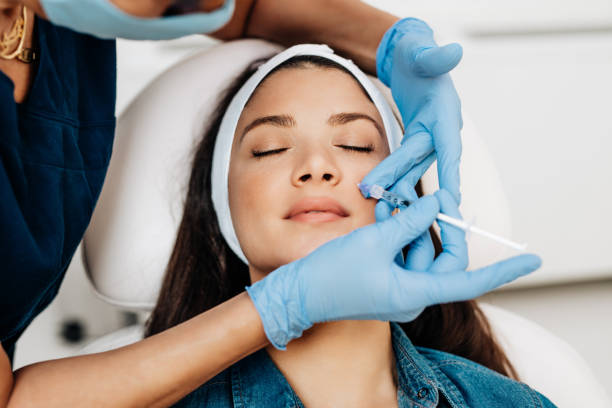
Woman while procedure lip augmentation at cosmetology clinic with beautician. Filler injection for beautiful female lips augmentation with hyaluronic, top view
Dermal fillers have become increasingly popular as a non-invasive way to reduce the signs of aging. However, dermal fillers may not be the right choice for everyone. Fortunately, there are several non-surgical alternatives to dermal fillers that can provide similar results with less risk and less downtime. Let’s take a look at some of the most popular non-surgical alternatives to dermal fillers that can help you achieve a younger, healthier look.
Introduction to Non-Surgical Options
Non-surgical options are gaining popularity as painless and less invasive alternatives to dermal fillers. Dermal fillers offer a quick fix to aging skin, but the results are not long-lasting and can have adverse effects. Therefore, many people are opting for non-surgical treatments that don’t require needles or incisions and have fewer side effects.
Microdermabrasion, chemical peels, topical treatments, and face yoga are among the most popular non-surgical alternatives to dermal fillers. These treatments aid in exfoliating the skin, improving collagen production, and tightening the facial muscles. While non-surgical treatments may not provide immediate results, they are less risky, longer-lasting, and more affordable than dermal fillers.
To improve the effectiveness of non-surgical treatments, ensure that you get your skincare products from reliable sources and follow the recommended procedures. Pro tip: Consulting a dermatologist will help you identify which non-surgical treatment will work best for your skin type.
Benefits of Non-Surgical Alternatives
Many people assume that dermal fillers are the only way to achieve a more youthful and refreshed appearance. However, non-surgical alternatives offer numerous benefits and can be just as effective.
Here are several benefits of non-surgical alternatives to dermal fillers:
- No downtime: Unlike dermal fillers, non-surgical alternatives typically do not require downtime for recovery. You can return to your normal activities right after your treatment.
- Budget-friendly: Non-surgical alternatives can be more budget-friendly than dermal fillers, which can be costly and require ongoing treatments. Non-surgical treatments are often a one-time investment.
- No needles or incisions: If you have a fear of needles or incisions, non-surgical alternatives may be a better option. Treatments like ultrasound, laser and radio frequency use non-invasive technology.
- Long-lasting results: While dermal fillers last an average of six to eighteen months, non-surgical alternatives using ultrasound or radiofrequency can produce long-lasting results of up to two years. It’s important to consult with a medical professional to determine which option is best for you.
Factors To Consider When Choosing Non-Surgical Alternatives
When considering non-surgical alternatives to dermal fillers, there are several important factors to consider to ensure that you choose the right treatment for your needs and preferences.
- Longevity: Dermal fillers last anywhere from 6 to 24 months, depending on the type of filler used. Non-surgical alternatives may have shorter or longer-lasting effects, so it’s important to consider whether you want a treatment that requires frequent maintenance or one that lasts longer with fewer touch-ups.
- Side Effects: While dermal fillers are generally safe, they can cause side effects like bruising, swelling, and redness. Non-surgical alternatives may have fewer side effects or different side effects that you may want to consider before choosing a treatment.
- Cost: Non-surgical alternatives to dermal fillers can range in cost depending on the treatment and the provider. It’s important to consider the cost of the treatment, as well as any associated maintenance costs, to determine whether it fits within your budget.
- Desired outcomes: Different non-surgical alternatives offer different outcomes. Some treatments emphasize wrinkle reduction or lifting/ tightening, while others are focused on skin rejuvenation. Consider what results you want to achieve and choose a treatment that aligns with those goals.
Pro-tip: Always consult with a licensed professional before making a decision on a non-surgical alternative to dermal fillers, and be sure to disclose any pre-existing medical conditions or allergies to avoid unwanted complications during or after treatment.
Hyaluronic Acid Stimulators
Because dermal fillers are temporary, hyaluronic acid (HA) stimulators are becoming increasingly popular for use as a non-surgical alternative to traditional dermal fillers. Hyaluronic acid stimulators are safe, non-invasive treatments that work with the body’s natural mechanisms to increase the production of HA in the skin. This can help to reduce the appearance of wrinkles and other signs of aging, and result in smoother, more hydrated skin with improved texture. So, how long do hyaluronic acid stimulators last compared to dermal fillers? Let’s take a closer look.
What Is a Hyaluronic Acid Stimulator?
Hyaluronic acid stimulators are non-surgical alternatives to dermal fillers that are designed to stimulate the production of natural hyaluronic acid in the body, providing longer-lasting results than traditional dermal fillers alone.
Unlike dermal fillers, hyaluronic acid stimulators encourage the body to produce more of its own hyaluronic acid, which is responsible for keeping skin plump, hydrated, and youthful-looking. By boosting the natural production of this essential substance, hyaluronic acid stimulators can help reduce the appearance of wrinkles, fine lines, and other signs of aging, with results that can typically last up to two years.
Popular examples of hyaluronic acid stimulators include Sculptra, Radiesse, and Bellafill, each of which works in slightly different ways to promote natural collagen and elastin production, leading to long-lasting improvements in skin texture, tone, and elasticity.

Pros and Cons of Using Hyaluronic Acid Stimulators
Hyaluronic acid stimulators are non-surgical alternative treatments to dermal fillers that aim to boost collagen and customize your anti-aging routine. However, there are both pros and cons of using these stimulators.
Pros:
- Long-lasting results: Unlike dermal fillers, hyaluronic acid stimulators can last up to two years or more with fewer maintenance appointments.
- Natural-looking results: They slowly build the collagen and hence look natural, subtle and gradually improve over time.
- Stimulate collagen production: The production of collagen is stimulated boosting the elasticity of the skin. This helps in reducing wrinkles and fine lines while promoting a youthful appearance.
Cons:
- Expensive: Hyaluronic acid stimulators are costly and require several sessions to achieve the desired results.
- Swelling and redness: The side effects may include swelling, redness, or itching in the injected area which lasts for a few hours to a few days.
- Risks: Like any medical treatment, hyaluronic acid stimulators have their own set of risks, such as infection, allergic reactions, and overstimulation leading to bumps or lumps.
Pro tip- Always consult a qualified and reputable dermatologist before undergoing any non-surgical treatments for anti-aging.
How Long Do Hyaluronic Acid Stimulators Last
Hyaluronic acid stimulators provide a longer-lasting solution to dermal fillers but still offer a non-invasive alternative. The duration of hyaluronic acid stimulators varies between products and can last up to two years. However, it’s essential to note that the effects can vary from person to person, depending on factors like lifestyle choices and metabolism.
Examples of popular hyaluronic acid stimulators include Sculptra, which can last up to 24 months, and Radiesse, lasting up to 18 months. These non-surgical treatments help stimulate the body’s natural production of collagen and elastin, resulting in a natural-looking youthful glow.
It’s crucial to consult with a certified and experienced aesthetic provider to determine the best hyaluronic acid stimulator treatment plan for you. Pro Tip: Following a healthy lifestyle such as regular physical exercise and a balanced diet can also help extend the results of hyaluronic acid stimulators.
Microneedling
Microneedling is a non-surgical alternative to dermal fillers. It involves the use of tiny needles to puncture the skin and stimulate the production of collagen and elastin, which can improve the skin’s texture and elasticity. This procedure can last for up to twelve months, offering a long-term solution for skin rejuvenation. Let’s dive deeper into what microneedling is and how it’ll help you.
Introduction to Microneedling
Microneedling is a minimally invasive cosmetic procedure that uses a device with tiny needles to puncture the skin and create small micro-channels. The process triggers the body’s natural healing process, which can stimulate collagen production and improve the appearance of fine lines, wrinkles, and scars.
Microneedling can be used on the face, neck, and body, and it is a safe and effective alternative to traditional dermal fillers. One major advantage of microneedling over fillers is that it can potentially last longer. While dermal fillers typically last between six months to two years, the effects of microneedling can last for up to five years. Additionally, microneedling has a shorter recovery time compared to other cosmetic procedures, making it an ideal choice for those looking for a quick, non-surgical solution for improving their skin’s appearance.
Pros and Cons of Using Microneedling as a Non-Surgical Alternative
Microneedling is a popular non-surgical alternative to dermal fillers for people looking to reduce the appearance of wrinkles, fine lines, and acne scars. While it offers benefits, there are also some drawbacks.
Pros:
Microneedling stimulates the production of collagen, the protein that keeps skin firm and healthy.
The treatment is minimally invasive, with little to no downtime.
Microneedling is suitable for all skin types.
Cons:
The results of microneedling are less dramatic and require multiple treatments.
There is a risk of infection if the equipment used is not properly sanitized.
Microneedling may cause skin irritation, particularly if the needles are too long or if the provider is not experienced.
In conclusion, microneedling offers a non-surgical alternative to dermal fillers with the added benefit of stimulating collagen production. However, it may not be suitable for everyone and requires multiple treatments before seeing significant results. It is essential to consult an experienced provider to avoid the risk of skin irritation or infection, particularly if you have sensitive skin.
How Long Do Microneedling Effects Last
Microneedling is a non-invasive cosmetic procedure that involves puncturing the skin with tiny sterile needles to stimulate collagen production, improve skin texture and reduce the appearance of fine lines and wrinkles. Microneedling effects can last up to 6 months or longer, depending on the individual’s skin type, age, and the severity of skin conditions being treated.
Dermal fillers, on the other hand, last anywhere from 6 months to 2 years depending on the type of filler used, the injection site and the individual’s metabolism. While dermal fillers can provide a more immediate result, microneedling offers a gradual improvement in skin texture and tone over time. Ultimately, the longevity of microneedling results depends on the individual’s skincare routine and overall skin health.
Chemical Peels
Chemical peels provide an effective and non-surgical alternative to dermal fillers. This treatment involves the application of certain acids that help to break down the top layers of the skin. As a result, this reduces the appearance of wrinkles and fine lines, giving your skin a smoother and more youthful look. Additionally, it also helps to even out skin tone, reduce hyper-pigmentation, and reduce the appearance of enlarged pores and acne scars. Let’s take a look at how this treatment works and how long it lasts.
Introduction To Chemical Peels
Chemical peels are a form of cosmetic treatment designed to improve the appearance of the skin on the face, neck, and hands. They are a popular non-surgical alternative to dermal fillers, which restore volume to the skin and smooth out wrinkles and fine lines. Unlike dermal fillers, which last for 6-12 months, the effects of chemical peels can last for several years.
Chemical peels are classified according to their strength and can range from superficial to deep peels. Superficial peels are the mildest form of chemical peel and can be used to treat minor skin issues such as acne scars and fine lines. Medium and deep peels are stronger and can treat more severe skin concerns such as age spots, deep wrinkles, and pigmentation issues.
While chemical peels are generally safe, it’s important to consult with a dermatologist or licensed esthetician before undergoing treatment to determine the best treatment plan for your individual skin type and concerns.

Pros and Cons of Using Chemical Peels as a Non-Surgical Alternative
Chemical peels are a popular non-surgical alternative to dermal fillers, but there are both pros and cons to this skincare treatment.
Pros:
1. Chemical peels can be used to reduce fine lines, wrinkles, and age spots
2. Chemical peels can improve skin texture and tone for a more youthful appearance
3. Can help reduce acne scars and hyperpigmentation
Cons:
1. Chemical peels can cause skin irritation, redness, and peeling
2. Some chemical peels require downtime for the skin to heal and recover
3. Chemical peels may not be suitable for all skin types, and can cause adverse reactions in sensitive skin
When compared to dermal fillers, chemical peels are a more affordable option but are not permanent, with results lasting between 6-12 months. Pro tip: Consult with a skincare professional to determine if a chemical peel is right for your skin type and concerns.
How Long Do Chemical Peels Results Last
Chemical peels are non-surgical alternatives to dermal fillers that can improve the appearance of your skin, but how long do the results last? The answer depends on the depth of the peel, the condition of your skin, and how well you take care of it post-treatment. Superficial peels provide mild exfoliation and a short-term boost in skin radiance, lasting for up to a month or two. Medium peels penetrate deeper into the skin, triggering more significant results, such as reducing the visibility of fine lines, wrinkles, and acne scars. Medium peels may last for up to six months or more with proper post-treatment care.
Deep peels provide deeper skin resurfacing and long-term results, such as improving the appearance of sun-damaged or aged skin. The results can last for several years with strict adherence to post-treatment care. It is important to note that the effects of a chemical peel are not permanent, and you will need to repeat the treatment to maintain the desired results.
Conclusion
When it comes to dermal fillers, there is no one-size-fits-all answer as to how long they will last. The duration of their effects can vary, depending on the type of fillers used, the area of the body, and the person’s individual metabolism. However, there are non-surgical alternatives to dermal fillers that can also offer longer-lasting results. In this article, we have discussed the various non-surgical alternatives to dermal fillers and their respective pros and cons.
Summary of Non-Surgical Options
If you’re looking for a non-surgical alternative to dermal fillers, there are several options available that can yield impressive results without the need for injections. Here’s a summary of some popular non-surgical options:
- Chemical peels: A chemical peel is a skin-resurfacing technique that uses a chemical solution to remove the top layer of skin, revealing smoother, younger-looking skin underneath.
- Microneedling: Microneedling uses a small, handheld device to create tiny punctures in the skin’s surface, triggering the body’s natural healing response and stimulating collagen production.
- Laser skin resurfacing: Laser skin resurfacing uses a laser to remove the top layer of skin, allowing healthier skin cells to grow in their place.
These non-surgical options can provide results that last up to several months, depending on factors such as age, skin type, and lifestyle habits. However, results are not as long-lasting as dermal fillers. It’s important to consult with a skincare professional to determine the best course of action for your individual needs.
Final Considerations
In conclusion, there are effective non-surgical alternatives to dermal fillers that can help you achieve a more youthful and rejuvenated appearance without the risks and side effects that come with injectables.
Some of these alternatives include facial exercises, facial massage, microneedling, and using topical skincare products containing retinoids and hyaluronic acid. However, it is important to note that the results of these alternatives may not be as long-lasting as dermal fillers, which can last anywhere from six months to two years, depending on the type of filler used and the area of injection.
Therefore, it is crucial to weigh the benefits and drawbacks of each option and make an informed decision based on your individual needs and preferences. It is advisable to consult a qualified dermatologist or aesthetician for guidance and advice on which option may be most suitable for you. Pro Tip: Maintain a healthy lifestyle and skincare routine to maximize the benefits of these non-surgical alternatives.
Recommendation For Follow-Up Care
If you’ve opted for non-surgical alternatives to dermal fillers, there are a few essential post-care steps you should follow to ensure the best possible results.
Here are some recommendations for follow-up care for non-surgical dermal fillers:
- Avoid touching the injection site for at least six hours after the procedure to reduce the risk of infection and irritation.
- Avoid excessive sun exposure for the first few days following the procedure, as this can lead to increased inflammation and swelling.
- Stay hydrated and maintain a healthy diet to encourage the body’s natural healing process and support collagen production.
- Apply ice to the injection site as needed to reduce swelling and discomfort.
- Follow up with your practitioner as recommended to ensure that the results are meeting your expectations and that any necessary adjustments are made.
Pro Tip: Dermal fillers can last anywhere from six months to two years, depending on the type of filler, the treatment area, and individual factors such as metabolism and lifestyle. Opting for non-surgical alternatives, like facial exercises, can help extend the lifespan of your dermal fillers.










